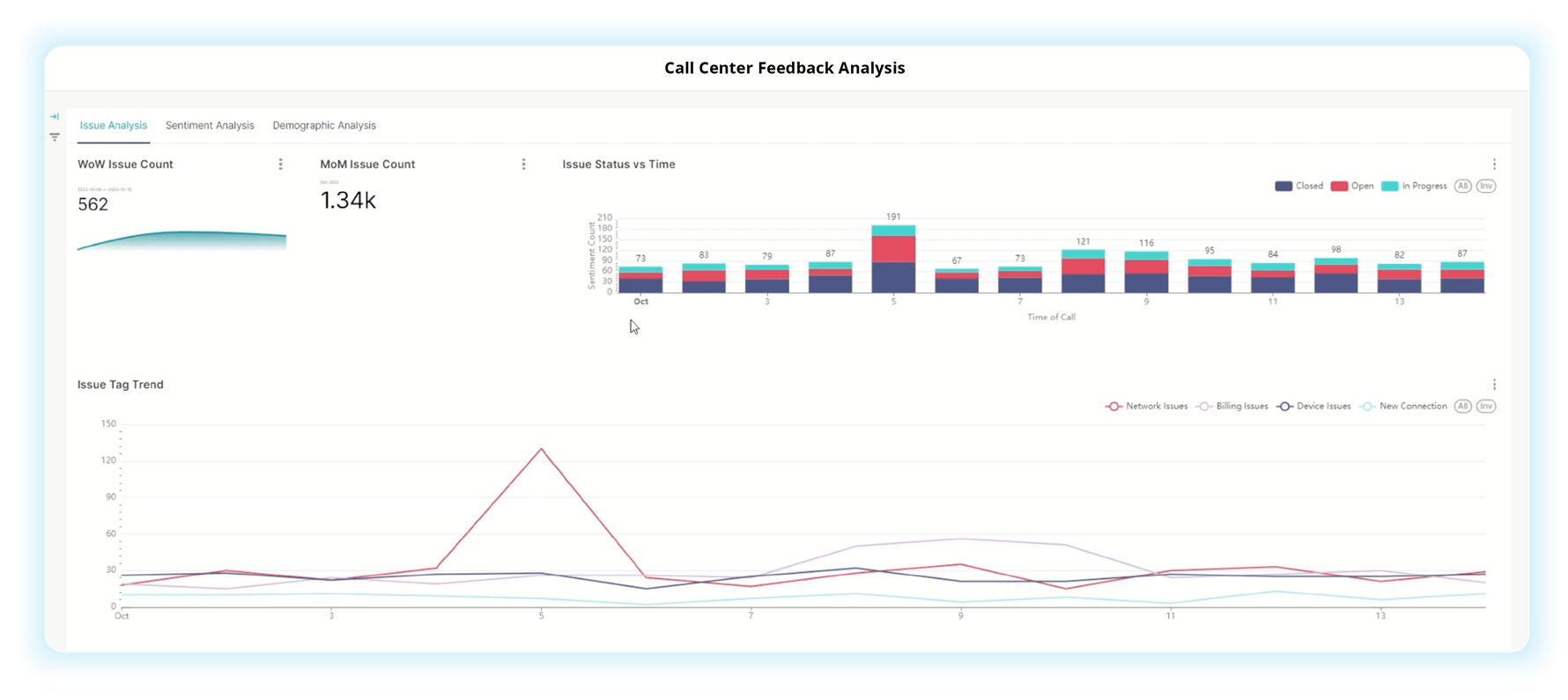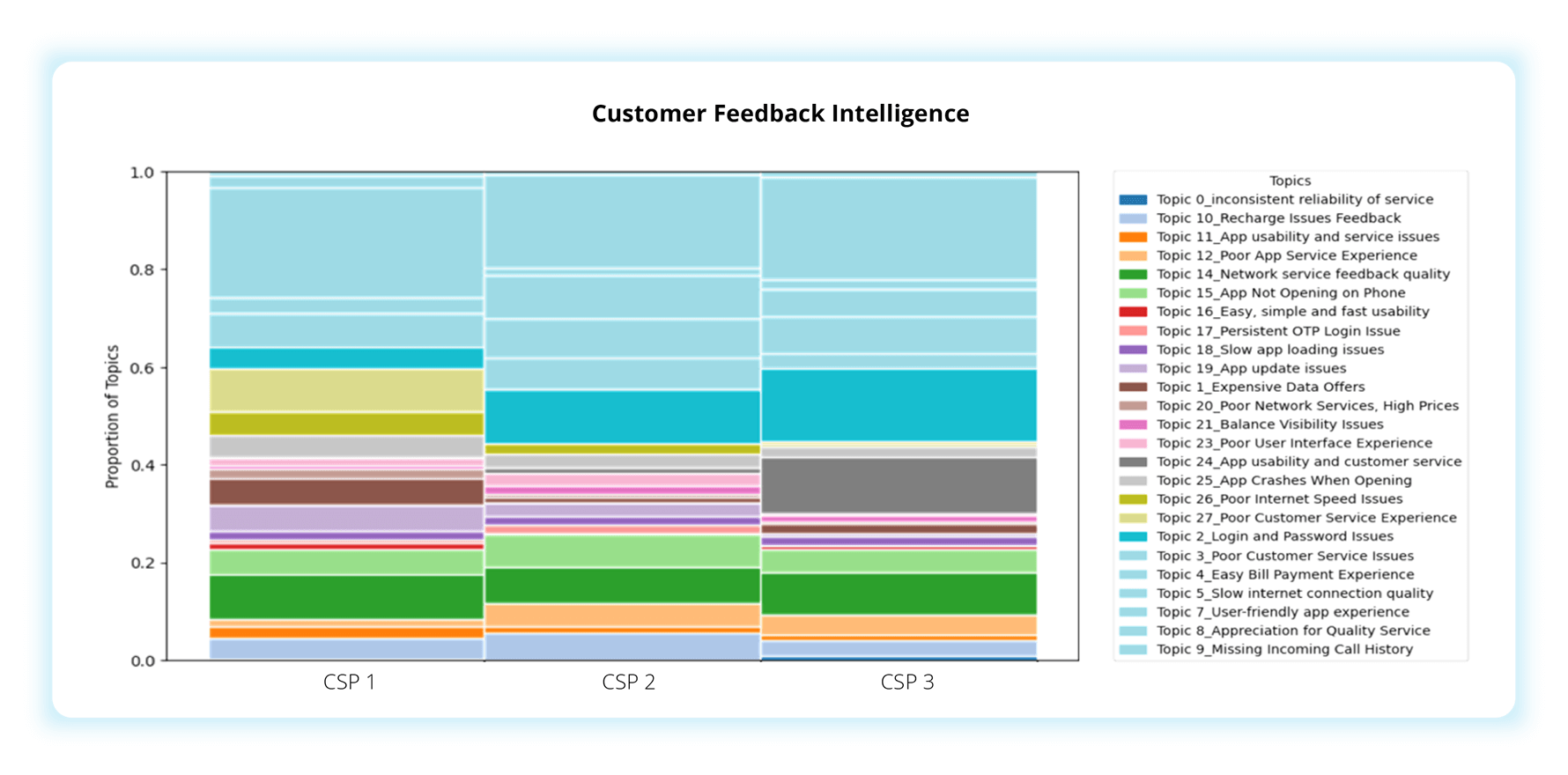Enhancing Telecom Call Center Performance with AI-Driven Feedback Analysis
In the high-stakes world of telecom, customer satisfaction isn’t just a nice-to-have—it’s the lifeline that keeps companies ahead of their competition. With millions of interactions flowing through telecom call centers every day, how a company responds to customer issues can make or break its reputation. The challenge? Identifying and resolving problems quickly before they spiral into dissatisfaction or churn. Enter AI-powered solutions, which are revolutionizing the way telecom operators analyze customer feedback and streamline their call center operations. By harnessing the power of AI, telecom companies can turn customer insights into actionable strategies, transforming their call centers from reactive trouble spots into proactive, value-driving assets.
AI-driven customer feedback analysis enables telecom companies to leverage cutting-edge technologies to sift through the vast amounts of data generated by call centers. By extracting valuable insights from customer interactions, these technologies can drastically improve operational efficiency, boost customer satisfaction, and even reduce churn. Let’s explore how telcos are using AI to revolutionize their call centers and enhance their overall performance.
The Power of AI in Telecom Call Centers
Telecom operators face unique challenges in managing their call centers, given the millions of customer interactions they handle daily. Customers reach out with questions about billing, technical support, service outages, and more. However, many of these calls are repetitive, with customers experiencing similar issues over time.
AI in Telecom has emerged as a game-changer in addressing these challenges. By using customer feedback analysis tools, operators can process large datasets from telecom call centers and extract actionable insights. This leads to more effective resolution of customer problems and faster responses to emerging service issues.
One of the most valuable applications of AI in telecom call centers is topic mining. This AI-driven technology automatically scans through millions of call transcripts, categorizing them into relevant themes, incident categories, and sub-categories. By identifying patterns in customer complaints and frequently asked questions, telecom operators can better understand the root causes of customer dissatisfaction.
What is Call Center Feedback analysis?

Topic Mining for Customer Feedback Intelligence

For example, a telecom company might receive thousands of calls daily related to billing disputes, network reliability issues, or service disruptions. Through topic mining, the system categorizes these calls and identifies the most frequent topics, allowing the company to focus on resolving the issues that matter most to its customers. This approach not only streamlines customer service operations but also provides telecom operators with insights that improve their strategic decision-making.
Case Study: How Topic Mining Transformed a Telecom Giant’s Call Center
Let’s look at a real-world example of a North American telecommunications conglomerate with over 115 million subscribers. With millions of customer interactions daily, the company struggled to keep pace with the volume of inquiries and complaints. Recognizing the need for a more scalable solution, they implemented a sophisticated AI-powered solution to analyze their telecom call center data through topic mining.
Key Findings from Topic Mining:
- Billing Issues: Approximately 25% of all calls were related to billing disputes and unclear statements. This issue had been underreported in previous internal assessments.
- Network Reliability: About 18% of calls pertained to network reliability, with many customers reporting service outages in specific regions that had not been fully addressed in operational planning.
Outcome:
The insights from topic mining allowed the telecom operator to make more informed, data-driven decisions, resulting in significant improvements across several key performance indicators (KPIs):
- Prioritized Problem Resolution: By identifying the most frequently mentioned issues, the operator was able to proactively address these problems, leading to a 20% reduction in incoming call volume.
- Enhanced Agent Training: The insights from topic mining empowered customer service representatives with better information to handle common queries. This reduced average handling time by 19%.
- Service Process Optimization: Based on the data-driven understanding of key pain points, the operator optimized its service processes. This included overhauling billing systems and improving network reliability in underperforming regions.
- Reduced Customer Churn: As a result of resolving these recurring issues, the operator saw a sharp increase in customer satisfaction scores (CSAT), from 66% to 84%, within just six months. Additionally, they experienced a notable reduction in churn rates, proving the effectiveness of churn prediction powered by AI.
This case study highlights how AI-powered solutions can revolutionize telecom call center performance. By automating the analysis of customer interactions and leveraging customer feedback intelligence, telecom operators can identify critical issues, streamline processes, and deliver a more personalized customer experience.
Improving Telecom Call Center Efficiency with AI-Driven Customer Insights
Reducing Call Volume and Repeat Interactions
One of the biggest challenges telecom call centers face is the high volume of incoming calls, many of which are repeat interactions. According to industry estimates, the average cost per call landing in a telecom call center ranges between $2 and $5. With approximately 29% of calls being repeat interactions due to unresolved issues, the financial impact on telecom operators is significant.
By using customer feedback analysis powered by AI, telecom companies can reduce the number of repeat calls by addressing the root causes of customer issues. This not only decreases operational costs but also frees up customer service representatives to focus on more complex inquiries.
The North American telecom operator from the case study managed to reduce their call volume by 20%, thanks to AI-powered customer feedback analysis. By addressing the most frequently mentioned issues, they were able to reduce the need for customers to call back multiple times.
Improving First-Call Resolution (FCR)
First-call resolution (FCR) is one of the most important metrics for telecom call centers. It measures the ability of the call center to resolve a customer’s issue during their first contact. Improving FCR not only enhances customer satisfaction but also reduces costs by minimizing the need for follow-up calls.
With customer feedback intelligence, telecom companies can significantly improve FCR rates. By providing customer service agents with actionable insights into recurring issues, AI empowers them to resolve more inquiries during the first call. In the case study, the telecom operator saw a 37% improvement in FCR rates after implementing their topic mining solution.
Enhancing Customer Satisfaction and Reducing Churn
In the competitive telecom industry, customer churn is a constant concern. High churn rates can erode profitability and damage brand reputation. One of the key drivers of churn is poor customer service, often resulting from unresolved issues or long wait times for resolutions.
AI-driven customer feedback analysis allows telecom companies to proactively address the issues that are most likely to drive churn. For example, if a large portion of customer complaints relates to billing disputes, telecom operators can prioritize billing system improvements to reduce dissatisfaction.
In the case study, the telecom operator achieved a 30% improvement in customer retention by proactively addressing the issues identified through AI-driven analytics. This demonstrates the powerful role AI can play in churn prediction and customer retention strategies.
Leveraging AI for Personalized Customer Experience
Another significant advantage of AI-driven customer feedback analysis is the ability to provide a more personalized customer experience. By analyzing customer interactions at scale, AI can uncover individual preferences and behaviors, allowing telecom companies to tailor their services accordingly.
For instance, if a customer frequently contacts the call center regarding network reliability in a specific region, the telecom company can proactively notify them about network maintenance or improvements in that area. This level of personalization not only improves the customer experience but also builds customer loyalty.
Predictive Analytics for Proactive Support
Predictive analytics, a key component of AI, enables telecom companies to anticipate customer needs before they arise. By analyzing historical data and identifying patterns in customer behavior, AI can predict when a customer is likely to encounter an issue and provide proactive support.
For example, if the AI system identifies a pattern of customers calling about service outages in a particular area, the telecom company can send out proactive notifications to customers in that region, offering solutions before they even need to call. This proactive approach not only reduces telecom call center volume but also enhances the customer experience.
Conclusion: AI Is the Future of Telecom Call Centers
As the telecom industry continues to evolve, the role of AI in optimizing call center performance will only grow. AI-powered solutions such as customer feedback analysis and topic mining provide telecom operators with the tools they need to improve customer satisfaction, reduce costs, and stay competitive in an increasingly crowded marketplace.
By leveraging AI to analyze vast amounts of customer interaction data, telecom companies can identify patterns, optimize service processes, and proactively address issues before they escalate. As seen in the case study, the implementation of AI in telecom call centers has the potential to deliver significant improvements in key performance metrics, including reduced call volume, higher first-call resolution rates, and improved customer satisfaction.
Ultimately, the telecom operators that invest in AI-driven customer feedback intelligence will be better equipped to meet the demands of modern customers and stay ahead of the competition. The future of call center performance lies in the seamless integration of AI technologies that not only enhance operational efficiency but also create a more personalized customer experience.
Transform your telecom call center with AI-driven insights today!


